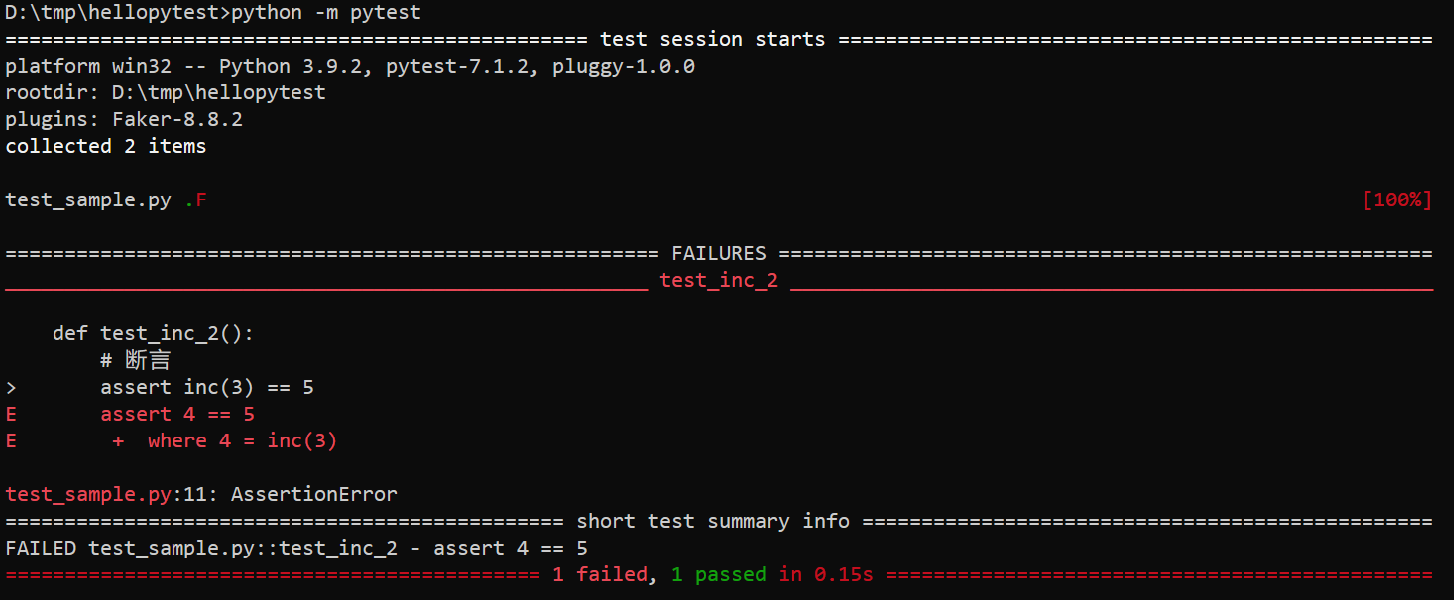[pytest]基础
简介
The
pytestframework makes it easy to write small, readable tests, and can scale to support complex functional testing for applications and libraries.
pytest是一个成熟的python测试框架,易于编写,小巧易读,扩展性高。
- 安装:
python -m pip install pytest(需要python 3.7+)
规范
在pytest测试框架中,需要遵循以下规范:
- 测试文件名要符合
test_*.py或*_test.py- 如果团队内之前没用过pytest,建议固定使用其中一个
- 示例:
test_login.py
- 测试类要以Test开头,且不能带有
__init__()方法- 示例:
class TestLogin:
- 示例:
- 在单个测试类中,可以有多个测试函数。测试函数名符合
test_*
示例代码1
- 编写
test_sample.py
def inc(x):
# 入参值加1
return x + 1
def test_inc_1():
# 断言
assert inc(3) == 4
def test_inc_2():
# 断言
assert inc(3) == 5
- 在代码所在目录下执行命令:
python -m pytest

示例代码2
- 编写
test_sample.py
import pytest
def test_001():
print("test_001")
def test_002():
print("test_002")
if __name__ == '__main__':
# 使用pytest.main()可以传入可执行参数,通过[]进行分割,[]内多个参数使用半角逗号分割
pytest.main(["-v", "test_sample.py"])
- 在代码所在目录下执行命令:
python test_sample.py

示例代码3-生成html格式的测试报告
- 编写
test_sample.py
import pytest
def inc(x):
return x + 1
def test_inc_1():
# 断言成功
assert inc(3) == 4
def test_inc_2():
# 断言失败
assert inc(3) == 5
users = ["zhaoda", "qianer", "sunsan", "lisi"]
def test_userin():
# 断言失败
assert "zhouwu" in users
if __name__ == '__main__':
# 测试test_sample.py文件,并生成html格式的测试报告
# 需要使用pip安装pytest-html
pytest.main(["--html=./report.html", "test_sample.py"])
- 在代码所在目录下执行命令:
python test_sample.py - 可以通过浏览器打开生成的html文件

示例代码4-接口测试
- 先用go语言写了一个简单的接口,传参
userId,返回username等用户信息。
package main
import (
"context"
"log"
"net/http"
"os"
"os/signal"
"syscall"
"time"
"github.com/gin-gonic/gin"
)
type ReqUserInfo struct {
UserId int `json:userId`
}
func f2(c *gin.Context) {
// 解析请求体
var req ReqUserInfo
if err := c.ShouldBindJSON(&req); err != nil {
c.JSON(http.StatusBadRequest, gin.H{
"ERROR": err.Error(),
})
return
}
var rsp struct {
UserId int `json:"userId"`
Username string `json:"username"`
UserSex int `json:"userSex"`
}
rsp.UserId = req.UserId
rsp.Username = "zhangsan"
rsp.UserSex = 0
c.JSON(http.StatusOK, rsp)
}
func main() {
// gin.SetMode(gin.ReleaseMode)
r := gin.Default()
r.GET("/user", f2)
// 设置程序优雅退出
srv := &http.Server{
Addr: "127.0.0.1:8000",
Handler: r,
}
go func() {
if err := srv.ListenAndServe(); err != nil && err != http.ErrServerClosed {
log.Fatalf("listen failed, %v\n", err)
}
}()
quit := make(chan os.Signal, 1)
signal.Notify(quit, os.Interrupt, syscall.SIGTERM, syscall.SIGINT)
<-quit
ctx, cancel := context.WithTimeout(context.Background(), time.Second)
defer cancel()
if err := srv.Shutdown(ctx); err != nil {
log.Fatalf("server shutdown failed, err: %v\n", err)
}
select {
case <-ctx.Done():
log.Println("timeout of 1 seconds")
}
log.Println("server shutdown")
}
- 运行服务端:
go run main.go - 编写测试代码:
test_user.py
import pytest
import requests
import json
def test_user():
url = "http://127.0.0.1:8000/user"
headers = {
"Content-Type": "application/json"
}
data = {
"userId": 123456,
}
req = requests.get(url=url, headers=headers, data=json.dumps(data))
print(req.text)
assert req.json()["username"] == "zhangsan"
if __name__ == '__main__':
pytest.main(["-v", "-s","test_user.py"])
- 执行测试:
python test_user.py

参考
本文来自博客园,作者:花酒锄作田,转载请注明原文链接:https://www.cnblogs.com/XY-Heruo/p/16254121.html



